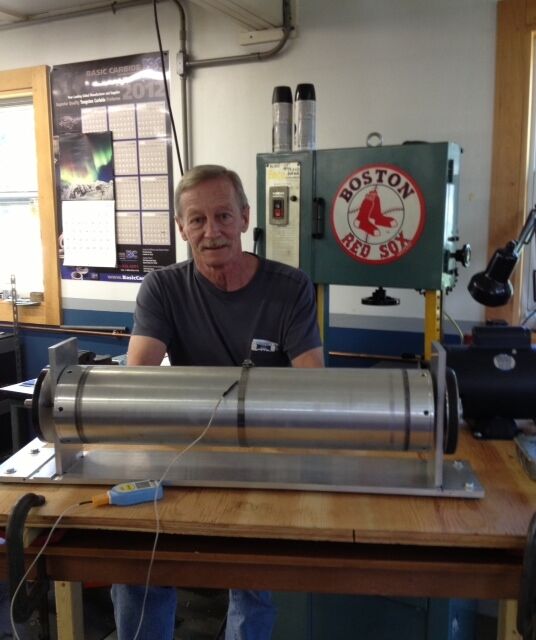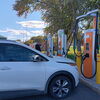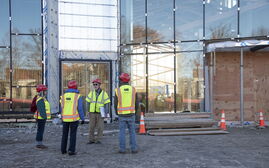Processing Your Payment
Please do not leave this page until complete. This can take a few moments.
- News
-
Editions
View Digital Editions
Biweekly Issues
- December 1, 2025
- Nov. 17, 2025
- November 03, 2025
- October 20, 2025
- October 6, 2025
- September 22, 2025
- + More
Special Editions
- Lists
- Viewpoints
-
Our Events
Event Info
Award Honorees
- Calendar
- Biz Marketplace
Inventor tests new heating device at USM
 Photo/Darren Fishell
Searsmont investor John Foster's heating cell in a laboratory at the University of Southern Maine's Gorham campus, where it is undergoing efficiency testing.
Photo/Darren Fishell
Searsmont investor John Foster's heating cell in a laboratory at the University of Southern Maine's Gorham campus, where it is undergoing efficiency testing.
 Courtesy John Foster
Searsmont-based machinist and inventor John Foster with the heating cell he's hoping to commercialize after testing at the University of Southern Maine's Gorham campus.
Courtesy John Foster
Searsmont-based machinist and inventor John Foster with the heating cell he's hoping to commercialize after testing at the University of Southern Maine's Gorham campus.
At a gas station one February around four years ago, Searsmont machinist John Foster saw a man step out of a Ford Taurus wagon, pull a paint can from the trunk and fill it up with kerosene.
“I didn’t need a hit in the head to tell me this guy was there to get fuel oil for his home,” Foster says.
That image — coupled with the pain of his own recent oil bill — spurred Foster to develop an electric heating unit he says will be able to heat a three-bedroom home through the winter for $100-$120 a month.
“It would cost a fraction of conventional baseboard heating units or fuel oil,” Foster says.
The patent-pending device is still early in development and last week underwent independent testing in Gorham through the University of Southern Maine’s Campus Ventures program, which aims to help inventors and entrepreneurs test and commercialize products. Gregory Cavanaugh, program manager for USM’s Office of External Programs, which oversees Campus Ventures, says further efficiency testing will determine the true commercial potential for the product and its uncommon way to generate heat.
The cylindrical device uses friction to generate heat, powered by a half-horsepower motor and vegetable oil as a lubricant.
“My wife had vegetable oil, so I used it,” Foster says. “The biggest mistake was that I [also] grabbed the olive oil … but she was understanding.”
Cavanaugh says the evaluation from his program will lead to recommendations, including what improvements should be made before commercial production.
“In a production setting, we would vacuum seal the [heating] capsule and there would be no air in there,” Cavanaugh says. That air can create a mechanically undesirable effect called cavitation, where pockets of vapor form in a liquid. “That would make it much more expensive to manufacture, and I’m not sure that would return an equal amount of value in output,” he says.
The USM testing is expected to be concluded this week.
Bringing it to market
The determination of the device’s commercial potential will also consider how it stacks up against other devices, but Foster says he’s confident in his prior testing and is already lining up other resources, like business counseling advice through a counselor with SCORE.
In the tests from his Searsmont machine shop, Foster says he’s gotten the unit up to its maximum temperature of 225 degrees Fahrenheit using the electric motor that draws about as much power as blender.
Should his vision for the heating unit pan out, Foster expects attractive sales given the rising price of fuel oil. He says the other factor driving demand is safety. From 2008 to 2010, there were nearly 50,100 residential fires caused by heating units in the United States, according to the U.S. Fire Administration. Because his device has no flame and would ultimately consist of six cylindrical units enclosed in a larger casing, Foster says the threat of fire is drastically reduced compared with other heating units.
Cavanaugh says the safety aspect of the device could allow applications like providing safe heating in environments where there are explosive compounds, even if its efficiency testing results are underwhelming.
Foster, who has licensed multiple patents on automotive and other mechanical devices, says he hopes this invention is the one that will reach commercial success. And regardless of the test results on his prototype, he says, he’s already lining up the first application of a full-scale model.
“No matter which way these tests go, I’m going to build one anyway,” Foster says.
Mainebiz web partners
Related Content

The Giving Guide
The Giving Guide helps nonprofits have the opportunity to showcase and differentiate their organizations so that businesses better understand how they can contribute to a nonprofit’s mission and work.
Learn More
Work for ME
Work for ME is a workforce development tool to help Maine’s employers target Maine’s emerging workforce. Work for ME highlights each industry, its impact on Maine’s economy, the jobs available to entry-level workers, the training and education needed to get a career started.
Learn More
Groundbreaking Maine
Whether you’re a developer, financer, architect, or industry enthusiast, Groundbreaking Maine is crafted to be your go-to source for valuable insights in Maine’s real estate and construction community.
Learn more-
The Giving Guide
The Giving Guide helps nonprofits have the opportunity to showcase and differentiate their organizations so that businesses better understand how they can contribute to a nonprofit’s mission and work.
-
Work for ME
Work for ME is a workforce development tool to help Maine’s employers target Maine’s emerging workforce. Work for ME highlights each industry, its impact on Maine’s economy, the jobs available to entry-level workers, the training and education needed to get a career started.
-
Groundbreaking Maine
Whether you’re a developer, financer, architect, or industry enthusiast, Groundbreaking Maine is crafted to be your go-to source for valuable insights in Maine’s real estate and construction community.
ABOUT
NEW ENGLAND BUSINESS MEDIA SITES
No articles left
Get access now
In order to use this feature, we need some information from you. You can also login or register for a free account.
By clicking submit you are agreeing to our cookie usage and Privacy Policy
Already have an account? Login
Already have an account? Login
Want to create an account? Register
Get access now
In order to use this feature, we need some information from you. You can also login or register for a free account.
By clicking submit you are agreeing to our cookie usage and Privacy Policy
Already have an account? Login
Already have an account? Login
Want to create an account? Register










Comments